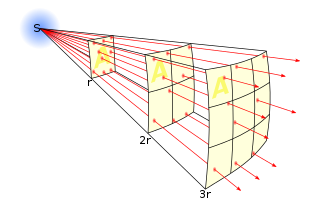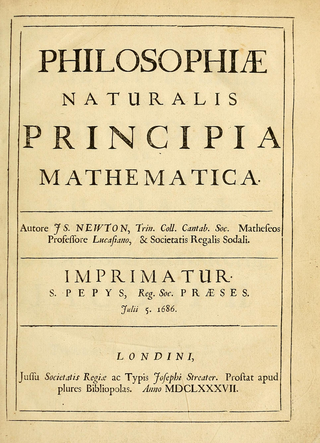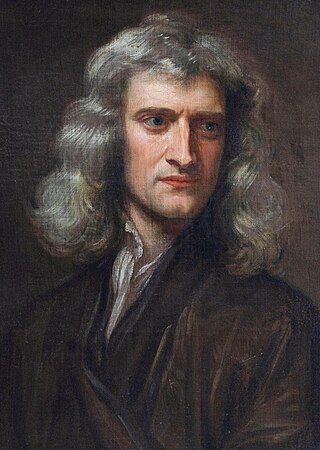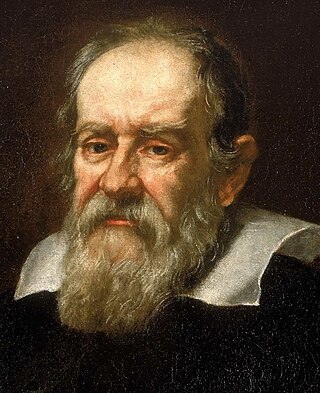Contents
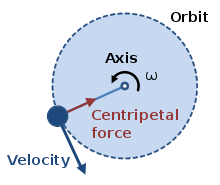
One of the surviving copies of De Motu was made by being entered in the Royal Society's register book, and its (Latin) text is available online. [4]
For ease of cross-reference to the contents of De Motu that appeared again in the Principia, there are online sources for the Principia in English translation, [5] as well as in Latin. [6]
De motu corporum in gyrum is short enough to set out here the contents of its different sections. It contains 11 propositions, labelled as 'theorems' and 'problems', some with corollaries. Before reaching this core subject-matter, Newton begins with some preliminaries:
- 3 Definitions:
- 1: 'Centripetal force' (Newton originated this term, and its first occurrence is in this document) impels or attracts a body to some point regarded as a center. (This reappears in Definition 5 of the Principia.)
- 2: 'Inherent force' of a body is defined in a way that prepares for the idea of inertia and of Newton's first law (in the absence of external force, a body continues in its state of motion either at rest or in uniform motion along a straight line). (Definition 3 of the Principia is to similar effect.)
- 3: 'Resistance': the property of a medium that regularly impedes motion.
- 4 Hypotheses:
- 1: Newton indicates that in the first 9 propositions below, resistance is assumed nil, then for the remaining (2) propositions, resistance is assumed proportional both to the speed of the body and to the density of the medium.
- 2: By its intrinsic force (alone) every body would progress uniformly in a straight line to infinity unless something external hinders that.
(Newton's later first law of motion is to similar effect, Law 1 in the Principia.)
- 3: Forces combine by a parallelogram rule. Newton treats them in effect as we now treat vectors. This point reappears in Corollaries 1 and 2 to the third law of motion, Law 3 in the Principia.
- 4: In the initial moments of effect of a centripetal force, the distance is proportional to the square of the time. (The context indicates that Newton was dealing here with infinitesimals or their limiting ratios.) This reappears in Book 1, Lemma 10 in the Principia.
Then follow two more preliminary points:
- 2 Lemmas:
- 1: Newton briefly sets out continued products of proportions involving differences:
- if A/(A–B) = B/(B–C) = C/(C–D) etc., then A/B = B/C = C/D etc.
- 2: All parallelograms touching a given ellipse (to be understood: at the endpoints of conjugate diameters) are equal in area.
Then follows Newton's main subject-matter, labelled as theorems, problems, corollaries and scholia:
Theorem 1
Theorem 1 demonstrates that where an orbiting body is subject only to a centripetal force, it follows that a radius vector, drawn from the body to the attracting center, sweeps out equal areas in equal times (no matter how the centripetal force varies with distance). (Newton uses for this derivation – as he does in later proofs in this De Motu, as well as in many parts of the later Principia – a limit argument of infinitesimal calculus in geometric form, [7] in which the area swept out by the radius vector is divided into triangle-sectors. They are of small and decreasing size considered to tend towards zero individually, while their number increases without limit.) This theorem appears again, with expanded explanation, as Proposition 1, Theorem 1, of the Principia.
Theorem 2
Theorem 2 considers a body moving uniformly in a circular orbit, and shows that for any given time-segment, the centripetal force (directed towards the center of the circle, treated here as a center of attraction) is proportional to the square of the arc-length traversed, and inversely proportional to the radius. (This subject reappears as Proposition 4, Theorem 4 in the Principia, and the corollaries here reappear also.)
Corollary 1 then points out that the centripetal force is proportional to V2/R, where V is the orbital speed and R the circular radius.
Corollary 2 shows that, putting this in another way, the centripetal force is proportional to (1/P2) * R where P is the orbital period.
Corollary 3 shows that if P2 is proportional to R, then the centripetal force would be independent of R.
Corollary 4 shows that if P2 is proportional to R2, then the centripetal force would be proportional to 1/R.
Corollary 5 shows that if P2 is proportional to R3, then the centripetal force would be proportional to 1/(R2).
A scholium then points out that the Corollary 5 relation (square of orbital period proportional to cube of orbital size) is observed to apply to the planets in their orbits around the Sun, and to the Galilean satellites orbiting Jupiter.
Theorem 3
Theorem 3 now evaluates the centripetal force in a non-circular orbit, using another geometrical limit argument, involving ratios of vanishingly small line-segments. The demonstration comes down to evaluating the curvature of the orbit as if it were made of infinitesimal arcs, and the centripetal force at any point is evaluated from the speed and the curvature of the local infinitesimal arc. This subject reappears in the Principia as Proposition 6 of Book 1.
A corollary then points out how it is possible in this way to determine the centripetal force for any given shape of orbit and center.
Problem 1 then explores the case of a circular orbit, assuming the center of attraction is on the circumference of the circle. A scholium points out that if the orbiting body were to reach such a center, it would then depart along the tangent. (Proposition 7 in the Principia.)
Problem 2 explores the case of an ellipse, where the center of attraction is at its center, and finds that the centripetal force to produce motion in that configuration would be directly proportional to the radius vector. (This material becomes Proposition 10, Problem 5 in the Principia.)
Problem 3 again explores the ellipse, but now treats the further case where the center of attraction is at one of its foci. "A body orbits in an ellipse: there is required the law of centripetal force tending to a focus of the ellipse." Here Newton finds the centripetal force to produce motion in this configuration would be inversely proportional to the square of the radius vector. (Translation: 'Therefore, the centripetal force is reciprocally as L X SP², that is, (reciprocally) in the doubled ratio [i.e., square] of the distance ... .') This becomes Proposition 11 in the Principia.
A scholium then points out that this Problem 3 proves that the planetary orbits are ellipses with the Sun at one focus. (Translation: 'The major planets orbit, therefore, in ellipses having a focus at the center of the Sun, and with their radii (vectores) drawn to the Sun describe areas proportional to the times, altogether (Latin: 'omnino') as Kepler supposed.') (This conclusion is reached after taking as initial fact the observed proportionality between square of orbital period and cube of orbital size, considered in corollary 5 to Theorem 1.) (A controversy over the cogency of the conclusion is described below.) The subject of Problem 3 becomes Proposition 11, Problem 6, in the Principia.
Theorem 4
Theorem 4 shows that with a centripetal force inversely proportional to the square of the radius vector, the time of revolution of a body in an elliptical orbit with a given major axis is the same as it would be for the body in a circular orbit with the same diameter as that major axis. (Proposition 15 in the Principia.)
A scholium points out how this enables determining the planetary ellipses and the locations of their foci by indirect measurements.
Problem 4 then explores, for the case of an inverse-square law of centripetal force, how to determine the orbital ellipse for a given starting position, speed, and direction of the orbiting body. Newton points out here, that if the speed is high enough, the orbit is no longer an ellipse, but is instead a parabola or hyperbola. He also identifies a geometrical criterion for distinguishing between the elliptical case and the others, based on the calculated size of the latus rectum, as a proportion to the distance the orbiting body at closest approach to the center. (Proposition 17 in the Principia.)
A scholium then remarks that a bonus of this demonstration is that it allows definition of the orbits of comets and enables an estimation of their periods and returns where the orbits are elliptical. Some practical difficulties of implementing this are also discussed.
Finally in the series of propositions based on zero resistance from any medium, Problem 5 discusses the case of a degenerate elliptical orbit, amounting to a straight-line fall towards or ejection from the attracting center. (Proposition 32 in the Principia.)
A scholium points out how problems 4 and 5 would apply to projectiles in the atmosphere and to the fall of heavy bodies, if the atmospheric resistance could be assumed nil.
Lastly, Newton attempts to extend the results to the case where there is atmospheric resistance, considering first (Problem 6) the effects of resistance on inertial motion in a straight line, and then (Problem 7) the combined effects of resistance and a uniform centripetal force on motion towards/away from the center in a homogeneous medium. Both problems are addressed geometrically using hyperbolic constructions. These last two 'Problems' reappear in Book 2 of the Principia as Propositions 2 and 3.
Then a final scholium points out how problems 6 and 7 apply to the horizontal and vertical components of the motion of projectiles in the atmosphere (in this case neglecting earth curvature).





